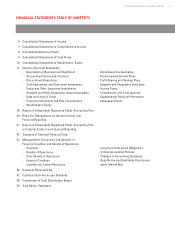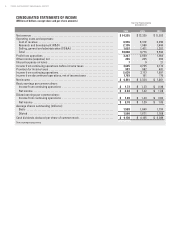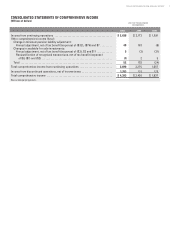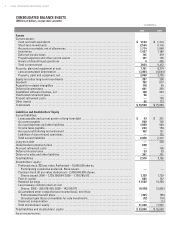Texas Instruments 2006 Annual Report Download - page 17
Download and view the complete annual report
Please find page 17 of the 2006 Texas Instruments annual report below. You can navigate through the pages in the report by either clicking on the pages listed below, or by using the keyword search tool below to find specific information within the annual report.
TEXAS INSTRUMENTS 2006 ANNUAL REPORT 1515
Effective July 1, 2005, we changed our method of determining expected volatility on all options granted after that date to rely
solely on available implied volatility rates rather than an analysis of historical volatility. After giving consideration to available
regulatory guidance, we believe that market-based measures of implied volatility are currently the best available indicators of
the expected volatility used in these estimates.
Expected lives of options are determined based on the historical share option exercise experience of our optionees, using a
rolling 10-year average. We believe the historical experience method is the best estimate of future exercise patterns currently
available.
Risk-free interest rates are determined using the implied yield currently available for zero-coupon U.S. government issues
with a remaining term equal to the expected life of the options.
Expected dividend yields are based on the approved annual dividend rate in effect and the current market price of TI common
stock at the time of grant. No assumption for a future dividend rate change has been included unless there is an approved
plan to change the dividend in the near term.
Inventories: Inventories are stated at the lower of cost or estimated net realizable value. Cost is generally computed on
a currently adjusted standard cost basis, which approximates costs on a first-in, first-out basis. Prior to January 1, 2006,
standard costs were based on the optimal utilization of installed factory capacity. With the adoption of SFAS No. 151,
“Inventory Costs, an amendment of ARB No. 43, Chapter 4,” effective January 1, 2006, standard costs are based on the normal
utilization of installed factory capacity, which is not materially different from the optimal rates previously used. The primary
impact to our inventory valuation methodology was to change how the fixed production overhead costs included in inventory
are calculated. The effect of this change for the year ended December 31, 2006, on inventory and net income was not material.
Costs associated with underutilization of capacity are expensed as incurred.
We conduct quarterly inventory reviews for salability and obsolescence. A specific allowance is provided for inventory
considered unlikely to be sold. Remaining inventory has a salability and obsolescence allowance based upon the historical
disposal percentage. Inventory is written off in the period in which disposal occurs.
Property, Plant and Equipment and Other Capitalized Costs: Property, plant and equipment are stated at cost and depreciated
over their estimated useful lives. In 2006, these assets were depreciated using the straight-line method. Prior to 2006, these
assets were depreciated primarily using the 150 percent declining-balance method (see Change in Depreciation Method
below). Leasehold improvements are amortized using the straight-line method over the shorter of the remaining lease term
or the estimated useful lives of the improvements. Acquisition-related costs are amortized on a straight-line basis over the
estimated economic life of the assets. Capitalized software licenses generally are amortized on a straight-line basis over the
term of the license. Fully depreciated or amortized assets are written off against accumulated depreciation or amortization.
Change in Depreciation Method: Effective January 1, 2006, as a result of a study made of the pattern of usage of our long-
lived depreciable assets, we adopted the straight-line method of depreciation for all property, plant and equipment. Under
the provisions of SFAS No. 154, “Accounting Changes and Error Corrections, a replacement of APB Opinion No. 20 and FASB
Statement No. 3,” which became effective as of January 1, 2006, a change in depreciation method is treated on a prospective
basis as a change in estimate. Prior period results have not been restated. We believe that the change from the 150 percent
declining-balance method to the straight-line method better reflects the pattern of consumption of the future benefits to
be derived from those assets being depreciated and provides a better matching of costs and revenues over the assets’
estimated useful lives. The effect of the change in depreciation method for the year ended December 31, 2006, was to reduce
depreciation expense by $156 million and increase both income from continuing operations and net income by $77 million
($0.05 per share).
Equity and Other Long-term Investments: All investments in equity and debt securities are classified as available for sale
except for investments in certain mutual funds (described below) that are held to offset deferred compensation liabilities.
Equity investments held at December 31, 2006 and 2005, include publicly traded marketable securities and private investments,
which are generally non-marketable. Investments in marketable equity and debt securities are stated at fair value, which
is based on market quotes. Adjustments to fair value of these investments are recorded as an increase or decrease in the
accumulated other comprehensive income section of stockholders’ equity except where losses are considered to be other
than temporary, in which case the losses are recorded as expenses in other income (expense) net. Marketable equity
securities and other long-term investments are considered other-than-temporarily impaired if they have traded below their
cost basis for more than six months.
Investments in non-marketable equity securities, primarily comprised of investments in early stage development companies
and various venture capital funds, are stated at historical cost and are subject to a periodic impairment review. Any
























